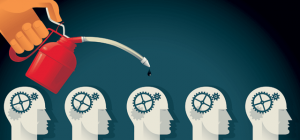
In the popular mystery series by David A. Adler, fifth grade detective Cam Jansen captures photographic memories by simply shutting her eyes and saying “click”—but there is a reason why her character is fictional.
Photographic memory is the ability to take clear mental snapshots of scenes and retrieve them in an instant. It is what many people, including admirers of Cam Jansen, wish they had. Some people have definitely come close in real life, performing extraordinary feats of memory. Still, what these individuals have cannot rightly be called photographic memory, because science has revealed that photographic memory is a myth. Instead, mental peculiarities allow some people to retain extraordinarily graphic memories for short periods of time. Others have practiced techniques to improve their own memories.
But nobody actually achieves photographic memory. To be blunt, it is impossible. A 2010 study showed that visual memories are not simply copies of visual stimuli. In the case of photographic memory, scientists would expect to see people encoding and retrieving integrated, whole memories of visual scenes. But people actually retain different visual information in different areas of the brain. While information about object appearance is stored in areas of the prefrontal and anterior cingulate cortices in the front of the brain, information about viewpoint is stored in the parahippocampal gyrus near the base of the brain. These areas work together to create memory, and in effect, memory is comprised of spliced segments rather than Cam Jansen-style snapshots.

Although photographic memory is unrealistic, it resembles a rare condition called eidetic memory, and the media has often confused the two in sensational stories. Eidetic memory occurs in between two and fifteen percent of children. Eidetic memories are vivid images that linger in the mind for a few minutes, but fade away quickly and do not capture every detail.
So far, there is no definite neurological explanation for eidetic memory, but it could involve changes in the medial temporal lobe and hippocampus, which direct storage and retrieval of long-term memory. Neurons in these brain areas may have lower potentiation thresholds, meaning they store more sensory information with less stimulation. This condition occurs in children, but not in adults, because neurons rewire as children grow up so that memory relies more on using prior experiences, language, or mnemonic devices than it does on pure visualizations.
The media loves the idea of a young detective who instantly recalls clues, and thus perpetuates the myth of photographic memory to an amenable public. Photographic memory is highly coveted by ordinary people who dream of having impressive mental capacities, but who normally have trouble remembering where they left their keys.
Certain individuals with amazing memory have also bolstered the myth of photographic memory. One particular case was studied by a Harvard vision scientist in 1970: Elizabeth could apparently fuse two different patterns of 10,000 random dots in her brain, even though the patterns had been shown separately to her two eyes. Similarly, savant Kim Peek was said to memorize every page of the 9,000 or so books he read at astounding speeds. But experiments later showed that he had no corpus callosum to connect his brain’s hemispheres, which allotted him better language-processing skills on both sides of the brain. It was these enhanced language skills that were mistaken as photographic memory. Guinness World Record holders for most digits of pi memorized also provoke a widespread belief in photographic memory.
Furthermore, the myth has been extended by accounts of people with Asperger’s syndrome. People with this autism spectrum disorder are often fascinated by specific categories of things, and thus retain specific detailed memories. For example, someone with Asperger’s syndrome may memorize huge quantities of baseball statistics or exotic flower species. But once again, this is not a case of photographic memory.

Ordinary people need not rely on mental irregularities, but can take advantage of neuroplasticity, or the brain’s ability to form new neural pathways, to improve their memory. They can develop techniques such as chunking information into manageable portions, visualizing information along a path that is familiar (such as the route from dorm to gym), or repeating new information multiple times. While chunking trains the prefrontal cortex and increases short-term memory capacity in the brain, visualization and repetition promote long-term memory consolidation in the hippocampus.

With practice and persistence, we can develop an amazing—albeit, not photographic—memory. Unfortunately, we will never be able to live up to fifth grade Cam Jansen, who sees as clearly with her mind’s eye as with her real eyes.
